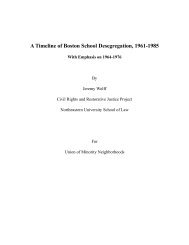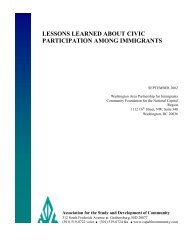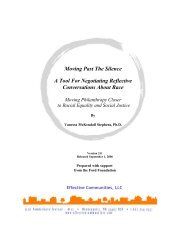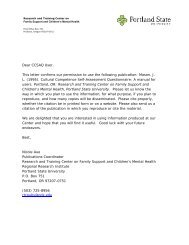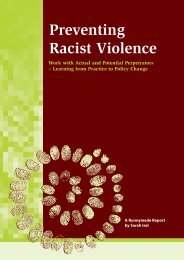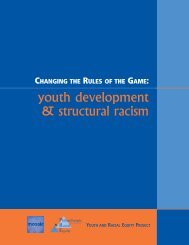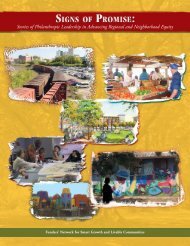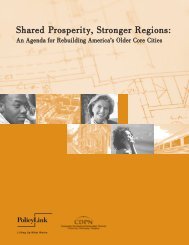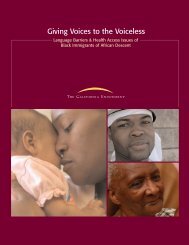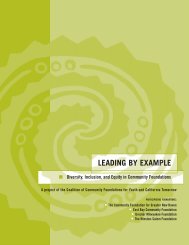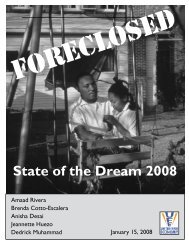Storytelling Approaches to Program Evaluation - The California ...
Storytelling Approaches to Program Evaluation - The California ...
Storytelling Approaches to Program Evaluation - The California ...
You also want an ePaper? Increase the reach of your titles
YUMPU automatically turns print PDFs into web optimized ePapers that Google loves.
NOVEMBER2007<strong>S<strong>to</strong>rytelling</strong> <strong>Approaches</strong><strong>to</strong> <strong>Program</strong> <strong>Evaluation</strong>:An IntroductionPICTURES WRITING THEATERFunded by:
This document provides apractical introduction <strong>to</strong> s<strong>to</strong>rytellingapproaches being successfully appliedin grassroots program evaluation.<strong>The</strong>se approaches can be used in almost any setting, with any numberof participants, in any language. <strong>The</strong>y are flexible and can be creativelytailored <strong>to</strong> the needs and styles of your particular organization or project.PICTURESWRITINGTHEATERAdapted by Sylvia Sukop from an original report by Joseph Tobin and Gustavo E. Fischman.
Table of ContentsIntroduction 2Gathering S<strong>to</strong>ries: Basic Interviewing <strong>Approaches</strong> 2S<strong>to</strong>ry Circle 3<strong>S<strong>to</strong>rytelling</strong> Interviews 3Oral His<strong>to</strong>ry Interviews 4Institutional Memory 4Getting Creative: Documenting S<strong>to</strong>ries in Pictures, Writing and <strong>The</strong>ater 4Visual Documentation 4Scrapbooking and S<strong>to</strong>ry-quilting 5S<strong>to</strong>ry <strong>The</strong>ater 5Case Studies 6Vignettes: Short S<strong>to</strong>ries as Illustration 6Five Tips for Gathering and Organizing S<strong>to</strong>ries 6<strong>Evaluation</strong> and Beyond: Using the S<strong>to</strong>ries you Collect 7Public Relations and Fund Raising 7Policy Advocacy 8
<strong>The</strong>re is no “one-size-fits-all”approach <strong>to</strong> program evaluation.Evaluating the impact of programs aimedat social change and involving diverseconstituents demands especially innovativeand culturally appropriate approaches.<strong>S<strong>to</strong>rytelling</strong> is proving <strong>to</strong> bea highly effective, culturallyappropriate approach <strong>to</strong>grassroots program evaluationthat gives voice <strong>to</strong> individualand collective experience.IntroductionTraditional evaluation methodologies–whichrely on formal questionnaires and statisticaldata that can be scientifically analyzed–fail<strong>to</strong> give program participants a chance <strong>to</strong> telltheir own s<strong>to</strong>ries in their own ways.<strong>S<strong>to</strong>rytelling</strong> is an ancient tradition thathas, over time and across cultures, servedmany different purposes, from educationand the transmission of values <strong>to</strong>political mobilization and pureentertainment. It can takemany forms, from oral andwritten narratives <strong>to</strong> gesture,movement, art, music,movies and more.<strong>S<strong>to</strong>rytelling</strong> is a powerful mode ofhuman expression and a sophisticatedform of “meaning-making.” It beginswith a s<strong>to</strong>ryteller, a singular experience,a unique point of view.This is one reason that s<strong>to</strong>rytelling hasbecome such a useful <strong>to</strong>ol in programevaluation: It accommodates diverse voicesand perspectives, while making the most ofthe particular resources and ways of learningreadily available in your program. Unlike atraditional evaluation approach that isimposed from outside, the s<strong>to</strong>rytellingapproach emerges organically from within yourown organization, projects and participants.Gathering S<strong>to</strong>ries: BasicInterviewing <strong>Approaches</strong><strong>The</strong>se basic approaches use a simpleinterview or question-and-answer format.<strong>The</strong>re should always be a clearly designatedinterviewer or facilita<strong>to</strong>r guiding theconversation. Ideally the conversation willbe recorded (audio or video) or detailednotes will be taken. Using these recordingsand notes, you will be able <strong>to</strong> share thes<strong>to</strong>ries you have gathered with others. Before2STORYTELLING APPROACHES TO PROGRAM EVALUATION: AN INTRODUCTION
Why <strong>S<strong>to</strong>rytelling</strong> Works• <strong>S<strong>to</strong>rytelling</strong> values and respects diverse ways of knowing and learning.It is empowering and participa<strong>to</strong>ry, and is based on popular knowledge.• S<strong>to</strong>ries can be used effectively alongside statistics and surveys.Including s<strong>to</strong>ries in your program evaluations puts a face on the facts and figures,and helps you figure out what’s working, what’s not, and why.• S<strong>to</strong>ries speak <strong>to</strong> a broad audience.Including your stakeholders’ voices and perspectives can help you communicate<strong>to</strong> your stakeholders, your funders, and the larger community what you areaccomplishing and why your program is so important.you get started, be sure <strong>to</strong> read “Tips forGathering and Organizing S<strong>to</strong>ries” (page 6).S<strong>to</strong>ry CircleAt the end of a staff meeting or sessiongo around the group in a circle asking foreach participant <strong>to</strong> share a s<strong>to</strong>ry. To getthe conversation going, the intervieweror facilita<strong>to</strong>r can ask an open-endedquestion like, “What have you learnedfrom being part of this program?” or“How has participation in this programchanged your life?”At the end of the session ask the group<strong>to</strong> summarize the most important lessonslearned based on the s<strong>to</strong>ries <strong>to</strong>ld in the circle,and be sure <strong>to</strong> record or write these down.You can implement the s<strong>to</strong>ry circle everythree <strong>to</strong> six months <strong>to</strong> assess your programprogress and involve diverse stakeholders.<strong>S<strong>to</strong>rytelling</strong> InterviewsEveryone has a s<strong>to</strong>ry <strong>to</strong> tell, but manypeople need help <strong>to</strong> get their s<strong>to</strong>ries out.One or more staff members can sit downwith program participants one-on-one orin small groups <strong>to</strong> gather their s<strong>to</strong>ries.<strong>The</strong> interviewer can begin by explainingthe purpose of the meeting, by sayingsomething like, “Our agency wants <strong>to</strong>hear from our participants abouthow our programs are helpingthem. Hearing your experiencewill help us know how we are doingand give us ideas for improvement.”<strong>The</strong> interviewer shouldask questions <strong>to</strong> get theperson talking, but notinterrupt unnecessarily.<strong>The</strong> interviewer can askthe participant <strong>to</strong> describe:Including s<strong>to</strong>ries inyour program evaluationsputs a face on the factsand figures, and helps youfigure out what’s working,what’s not and why.• <strong>The</strong> problems he/she is facing thatled him/her <strong>to</strong> come <strong>to</strong> the agency;GATHERING STORIES: BASIC INTERVIEWING APPROACHES 3
See “Tell Us YourS<strong>to</strong>ry” HandoutThis handout can be used <strong>to</strong>guide your interview and evenshared with participants inadvance, if appropriate.• <strong>The</strong> activities in whichhe/she has participatedor the services he/shehas been receiving;• How these servicesare making a differencein his/her life.<strong>The</strong> interviews should be taped and thentranscribed and edited, cutting out commentsthat are off <strong>to</strong>pic and focusing on the mostcompelling s<strong>to</strong>ries <strong>to</strong>ld by the participants.Oral His<strong>to</strong>ry InterviewsIncluding the voices of the people in acommunity who have familiarity with itshis<strong>to</strong>ry is a way <strong>to</strong> gather information onhow it has changed over time. It can help <strong>to</strong>describe the his<strong>to</strong>rical, social and culturalcontext of your program as well as how thecommunity and the program have evolvedover time. In addition, it can help youidentify community cultural events thatexisted in the past that can becomeresources for the future.Oral his<strong>to</strong>ry interviews may also be used<strong>to</strong> collect information on the lives of yourstakeholders before you initiate your programactivities and then after your program hasconcluded, <strong>to</strong> see how their livesmay have changed as a resul<strong>to</strong>f their participation.Institutional MemoryCollecting and cataloguings<strong>to</strong>ries not only fromparticipants but also fromstaff can be an excellent wayof recording the his<strong>to</strong>ry and charting theprogress of a program and the growth of anorganization. For example, staff memberscan be asked <strong>to</strong> tell s<strong>to</strong>ries about how theprogram has evolved over time. <strong>The</strong>ses<strong>to</strong>ries can be recorded and transcribed.This process can provide program staff agrowing archive of s<strong>to</strong>ries that can beanalyzed <strong>to</strong> chart growth in individualprogram participants, staff members, theprogram and the organization as a whole.Getting Creative:Documenting S<strong>to</strong>riesin Pictures, Writingand <strong>The</strong>aterVisual DocumentationS<strong>to</strong>ries can be <strong>to</strong>ld in pictures as well aswords. <strong>Program</strong> staff and participants canbe given cameras and invited <strong>to</strong> create avisual record of their participation in theprogram. <strong>The</strong>se pho<strong>to</strong>s can be organizedin<strong>to</strong> a montage on a poster or presented ina digital slide show <strong>to</strong> demonstrate programactivities and growth. This participa<strong>to</strong>ryevaluation approach is called “Pho<strong>to</strong>voice.”It utilizes pho<strong>to</strong>graphs taken by programstakeholders <strong>to</strong> enhance need assessments,discussions and reflection, gather data,promote dialogue, conduct participa<strong>to</strong>ryevaluations and communicate results withvarious audiences, including policymakers.Similar approaches can be done with videocameras, and when shared through computers,the approach is called “Digital <strong>S<strong>to</strong>rytelling</strong>.”With participants’ permission, it is best<strong>to</strong> save the s<strong>to</strong>ries as digital files. S<strong>to</strong>ries4STORYTELLING APPROACHES TO PROGRAM EVALUATION: AN INTRODUCTION
can then be selected <strong>to</strong> depict specificprogram impacts, successes and challenges,including diverse views and perspectiveson how the program has impacted the livesof involved stakeholders and, possibly, thelives of their communities.Scrapbooking and S<strong>to</strong>ry-quiltingCollecting artifacts and images and placingthem in an album <strong>to</strong> document programactivities, process and outcomes is a veryold practice that has recently become apopular hobby. Participants and staff can beasked <strong>to</strong> keep a scrapbook throughout theirparticipation in a program <strong>to</strong> document theiractivities, challenges, accomplishmentsand growth. <strong>The</strong>se scrapbooks can thenbe used as a form of portfolio assessmentin program evaluation.Quilting is another folk craft that can beused for telling s<strong>to</strong>ries. For example, in aquilt-making activity, each participant cancontribute a square that contains a personalreflection on the program, its process andoutcomes. <strong>The</strong> participants can discuss how<strong>to</strong> organize their squares <strong>to</strong> make a quiltthat tells the s<strong>to</strong>ry of their individual andcollective experience. S<strong>to</strong>ry-quilting canbe used <strong>to</strong> assess and promote communitypride, by describing how the community hascome <strong>to</strong>gether <strong>to</strong> accomplish activities andmake changes that resulted in improvedcommunity life and a sense of belonging.S<strong>to</strong>ry <strong>The</strong>ater<strong>The</strong>ater has been used effectively in the fieldsof health and mental health services and insocial movements. <strong>The</strong>ater can dramatizecommunity concerns and demonstratepossible solutions by ordinary people whoare trained neither as playwrights nor ac<strong>to</strong>rs.Community members are asked <strong>to</strong> develops<strong>to</strong>ries that they turn in<strong>to</strong> scripts andperform, either for themselves or for thepublic. Most often, the script emergesfrom role-play exercises.Elements of s<strong>to</strong>ry theater can be adapted in<strong>to</strong>program evaluation. For example, every monthor two, you can ask your program participants<strong>to</strong> role-play the process, challenges andaccomplishments, as well as outcomes ofa program. If you tape the role plays (audioor video) over the course of a year, theyprovide a running record of growth.S<strong>to</strong>ry theater can also be anexcellent means <strong>to</strong> inform thecommunity about your programevaluation results. For example,an organization in <strong>California</strong>called Lideres Campesinas(Farmworker Women Leaders)writes short plays in whichthey describe the livesof women who haveexperienced domesticviolence and howtheir lives changed asa result of becomingactive members ofthe organization.Online ResourcesPho<strong>to</strong>voicewww.pho<strong>to</strong>voice.com<strong>The</strong> Center forDigital <strong>S<strong>to</strong>rytelling</strong>www.s<strong>to</strong>rycenter.orgGETTING CREATIVE: DOCUMENTING STORIES IN PICTURES, WRITING AND THEATER 5
Vignettes are strongpersonal statementsthat give life–a humanface–<strong>to</strong> collected data.Case StudiesCase studies are more in-depth,written s<strong>to</strong>ries of the livesof your stakeholders. <strong>The</strong>ymay also depict the placeswhere they live, where yourorganization is located, and howcommunity life and other fac<strong>to</strong>rssuch as the environment and the socialdeterminants of health (e.g., employment,race and housing) interact with the processesand outcomes that emerge as a result ofyour stakeholders’ participation in yourprogram. A case study may include:• <strong>Program</strong> participants’ biographicalinformation;• <strong>The</strong>ir reasons for being involved;• <strong>The</strong> services they received or theactivities they participated in; and• Challenges, successes and outcomes.Vignettes: Short S<strong>to</strong>riesas IllustrationS<strong>to</strong>ries are used <strong>to</strong> illustrate andcontextualize the points you makewith facts and numbers. For example,after presenting statistical informationon the activities that you implementedin the past year, you can add a box thatcontains an account <strong>to</strong>ld by a staff memberor program participant that describes aparticular event that supports the statisticaldata. Vignettes are strong personal statementsthat give life–a human face–<strong>to</strong> collected data.Five Tips for Gatheringand Organizing S<strong>to</strong>ries1. Be consistent and systematic.Like keeping a diary, you need <strong>to</strong> have aplace <strong>to</strong> record your s<strong>to</strong>ries; you need <strong>to</strong>allow time <strong>to</strong> write them down and youneed <strong>to</strong> keep at it. Do a little at a timerather than waiting until a lot of timehas passed and trying <strong>to</strong> remember andrecord weeks or months of s<strong>to</strong>ries all a<strong>to</strong>nce. It’s easier <strong>to</strong> record s<strong>to</strong>ries whenthey are fresh in your mind than <strong>to</strong> goback and re-construct them.2. Designate S<strong>to</strong>rytellersand S<strong>to</strong>ry-collec<strong>to</strong>rs.Everyone has a s<strong>to</strong>ry <strong>to</strong> tell, but noteveryone is a good s<strong>to</strong>ryteller. Identifythe good s<strong>to</strong>rytellers among your staffand program participants and encouragethem <strong>to</strong> tell their s<strong>to</strong>ries and also <strong>to</strong>help other, less skilled s<strong>to</strong>rytellers, gettheir s<strong>to</strong>ries out. You also need <strong>to</strong>identify someone who takes primaryresponsibility for s<strong>to</strong>ry-collecting.By s<strong>to</strong>ry-collecting, we mean recording,writing and transcribing s<strong>to</strong>ries aboutyour program. This takes time and energy.You may want <strong>to</strong> train a staff member<strong>to</strong> be the designated s<strong>to</strong>ry-collec<strong>to</strong>rfor your agency or you may want <strong>to</strong>rotate the responsibility each monthor for each event.6STORYTELLING APPROACHES TO PROGRAM EVALUATION: AN INTRODUCTION
3. Be strategic in your choice of s<strong>to</strong>riesyou include in a program evaluation.Everybody has a s<strong>to</strong>ry <strong>to</strong> tell, but thisdoes not mean that every s<strong>to</strong>ry <strong>to</strong>ld <strong>to</strong>you by staff members and programparticipants needs <strong>to</strong> end up in yourreport. Strategically select the s<strong>to</strong>riesthat are most appropriate for the taskat hand—and these may not alwaysbe success s<strong>to</strong>ries! Certain s<strong>to</strong>ries mayillustrate problems and challengesencountered by your stakeholders;others may demonstrate your program’ssuccessful interventions or barriers <strong>to</strong>success; and still others may dramatizethe particular needs, assets and resourcesof the communities you serve.4. S<strong>to</strong>ries do not tell “the whole s<strong>to</strong>ry.”It is important that you complement thes<strong>to</strong>ries you include in your evaluationreport with other sources of information.S<strong>to</strong>ries should be combined with surveys,focus groups, observations and othermethods of evaluation. Providingmultiple forms of data and includingthe perspectives of the full range ofyour participants will enhance thequality of your program evaluationas well as the your s<strong>to</strong>ries’ impact.5. Consider the ethical implications ofsharing personal and institutionals<strong>to</strong>ries. Always ask participants forpermission before recording theirs<strong>to</strong>ries. Also get their approval <strong>to</strong>share with others the s<strong>to</strong>ries they tellyou, explaining that their real namewill not be used in connection withtheir s<strong>to</strong>ries. It is good practice <strong>to</strong> havewritten consent (see sample consent formincluded with this document) <strong>to</strong> assureconfidentiality in the use of personalnarratives; and <strong>to</strong> apply responsible andethical research practices, ensuring thatthe human rights, dignity and welfareof human subjects are protected.<strong>Evaluation</strong> and Beyond:Using the S<strong>to</strong>ries you CollectYour participants’ s<strong>to</strong>ries can serve as apowerful <strong>to</strong>ol in service of your organization’sgoals. Think about the particular audiencethat you want <strong>to</strong> target, from fundersand policymakers <strong>to</strong> the media andthe general public.Public Relationsand Fund Raising<strong>Program</strong>s can use s<strong>to</strong>rytellingfor publicity, fund raising andrecruitment of new participants,stakeholders, volunteersand staff. <strong>The</strong> same s<strong>to</strong>riesyou use for evaluationcan be used <strong>to</strong> explain<strong>to</strong> potential participants,other community serviceorganizations, potential fundersand the mediawho you are, whatyou do, what youhave accomplished,successes and challenges,and what you need.It is good practice <strong>to</strong>have written consent.See Sample ConsentForm Included inthis Brochure.EVALUATION AND BEYOND: USING THE STORIES YOU COLLECT 7
Policy AdvocacyCompelling humans<strong>to</strong>ries will strengthenyour policy advocacymessage. S<strong>to</strong>ries of yourparticipants’ struggles and howyour program helped <strong>to</strong> mitigate them canbe used <strong>to</strong> raise awareness of your programimpacts. S<strong>to</strong>ries of their resiliency and ofthe gains they make in your program canbe used not just for funding but alsofor social and systemic change.How <strong>to</strong> Disseminate Your S<strong>to</strong>riesSelect statements from your s<strong>to</strong>ries that “speak <strong>to</strong>” specific audiences and presentthem in the appropriate format for that audience.• For funders: Write an evaluation report with an executive summary that highlights,in brief, the main s<strong>to</strong>ries compiled in your report.• For policymakers: Write policy briefs that incorporate vignettes of your mostcompelling s<strong>to</strong>ries along with salient facts and figures.• For the media: Write a press release that includes one or more compelling s<strong>to</strong>riesand includes direct quotes from participants.• For community members and stakeholders: Weave s<strong>to</strong>ries and quotes in<strong>to</strong> yourorganization’s publications such as newsletters, brochures and annual reports. Writean article in a popular community newspaper or a community newsletter. Use s<strong>to</strong>rytheater <strong>to</strong> dramatize community concerns and potential solutions.8STORYTELLING APPROACHES TO PROGRAM EVALUATION: AN INTRODUCTION
Tell Us Your S<strong>to</strong>ryHearing your experience will help us know howwe are doing and give us ideas for improvement.1First, tell us a little about yourself.2Please describe the problem or problems you were facing that first led you <strong>to</strong> come <strong>to</strong> us.3Describe some of the activities in which you have participated or the services you havebeen receiving.4Have these activities or services made a difference in your life?5Looking ahead, what are some of the new or continuing challenges that you expect <strong>to</strong>face? Do you plan <strong>to</strong> continue participating in our programs?
Consent FormWe would like <strong>to</strong> assess the impact of your participation in our activities and services bymaking audio or video recordings of your s<strong>to</strong>ries. Through this assessment, our organizationwill learn what worked and what did not work and why. This learning will help us improveour programs and services.We may also use the products of our assessments <strong>to</strong> share the s<strong>to</strong>ries we collect with ourcommunity and other stakeholders or <strong>to</strong> advocate for our clients’ needs. We may use theseproducts <strong>to</strong> publish our accomplishments and <strong>to</strong> seek support for our ongoing services,program(s), and/or activities. We may publish information, s<strong>to</strong>ries, pho<strong>to</strong>graphs and artworkthrough various media—including but not limited <strong>to</strong> print, electronic and audio-videorecordings. Examples of these publications may include but are not limited <strong>to</strong> newsletters,brochures, reports, Web sites, slideshows, PowerPoint presentations, program pho<strong>to</strong> albumsand/or audio-visual public service announcements.No media shall be used for exploitation or promotion of activities unrelated <strong>to</strong> the missionof our organization, .Please complete and return this form <strong>to</strong> our office. In order <strong>to</strong> register for our program, theform must be completed, signed and returned regardless of your decision.Your Name/Youth’s NameDate of Birth / / (month/date/year) Today’s Date / /I GIVEpermission <strong>to</strong> publish my name/child’s name, image, written work and/or artwork forthe purposes stated above.(organization’s name)I DO NOT GIVE permission <strong>to</strong> publish my name/child’s name, image, written workand/or artwork for the purposes stated above.Signature<strong>Program</strong> Participant or Parent/GuardianPrint Name<strong>Program</strong> Participant or Parent/GuardianOffice Use Only:
STORYTELLING APPROACHES TO PROGRAM EVALUATION: AN INTRODUCTIONEvaluating the impact of programs aimed at social changeand involving diverse constituents demands especiallyinnovative and culturally appropriate approaches.
Evaluateyour programsby s<strong>to</strong>rytelling.Everyone has a s<strong>to</strong>ry<strong>to</strong> tell, but many peopleneed help <strong>to</strong> gettheir s<strong>to</strong>ries out.1000 North Alameda StreetLos Angeles, CA 90012800.449.4149www.calendow.org© 2007 <strong>The</strong> <strong>California</strong> EndowmentCPA/<strong>S<strong>to</strong>rytelling</strong>TCE 1019-07



